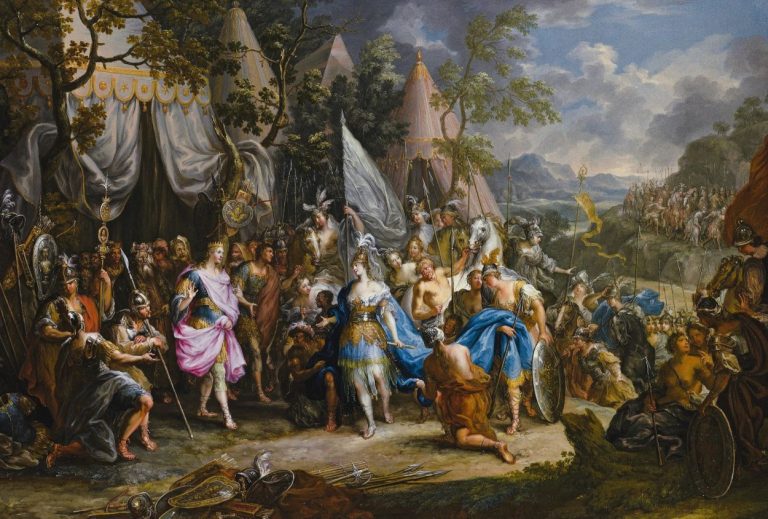

Past environmentalism had sought to preserve nature for scenic, recreational, or resource-extraction purposes.

By Dr. Robyn Gulliver
Social Scientist and Research Fellow
Crawford School of Public Policy, Australian National University (ANU)
School of Communication and Arts, University of Queensland
Concern around nuclear technology triggered a new phase in the modern Australian environmental movement. In the 1970s, there was an explosion of protest across Queensland, as growing awareness of the impacts of uranium mining and nuclear testing galvanized public concern into action. Local Friends of the Earth (FoE) groups, the Movement Against Uranium Mining (MAUM), Campaign Against Nuclear Energy (CANE), and the Uranium Moratorium all produced hundreds of flyers, pamphlets, reports, and broadsheets presenting their arguments against nuclear power, mines, and bombs.
However, despite the antinuclear movement’s foundational role in the development of Australia’s modern environmental movement, it is unclear whether environmentalists’ fears of a nuclear apocalypse reflected concerns about nature’s intrinsic value (Figure 1). Past environmentalism had sought to preserve nature for scenic, recreational, or resource-extraction purposes. Drawing on antinuclear-movement ephemera held at Fryer Library at the University of Queensland, this article explores whether fears of nuclear catastrophe changed this perspective.
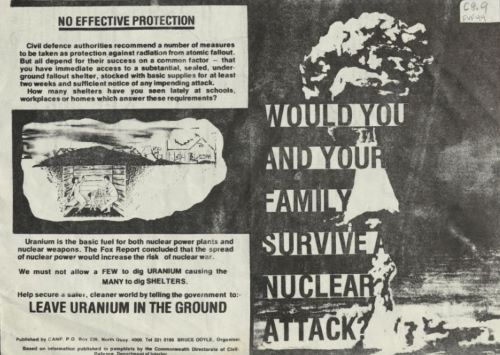
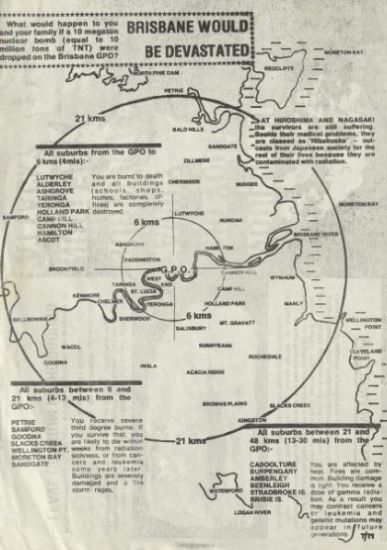
These materials present images of mutated children, starving communities, and circles of radioactive fallout (Figure 2), which viscerally sought to make an unthinkable future real. Those seeking to avert this future used three arguments, which still resonate today: erosion of the rights of protesters, workers, and First Nations peoples; profiteering and power grabbing by the nuclear industry; and harms to human health. In these framings nature played an indirect role as a victim of nuclear apocalypse.
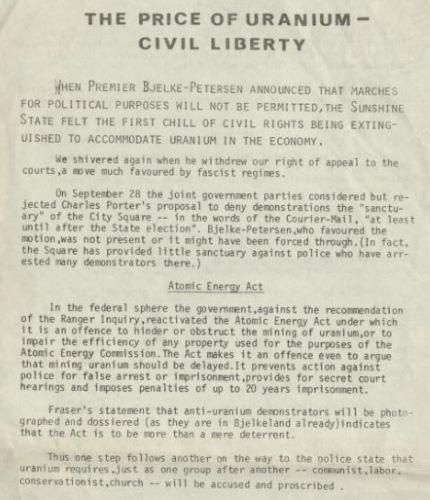
By 1978, protesters’ and workers’ rights were being persistently attacked in Queensland. The spread of antinuclear sentiment coincided with the institutionalized suppression of civil rights during the era of hard-line Premier Joh Bjelke-Peterson (Queensland Premier, 1968–1987), nicknamed “The Hillbilly Dictator.” He was known for supporting the use of force against protesters and the suppression of trade unions, and was said to have turned Queensland into a police state riddled with corruption. Bjelke-Peterson’s pro-uranium stance was matched at the federal level by Prime Minister Malcolm Fraser until 1983, as well as by his successor, Prime Minister Bob Hawke, who broke Labor’s “no new mines” pledge. Building on the wider alternative and protest movements and culture of the 1970s, Queensland antinuclear groups consistently highlighted the erosion of civil liberties in campaign materials (Figure 3).
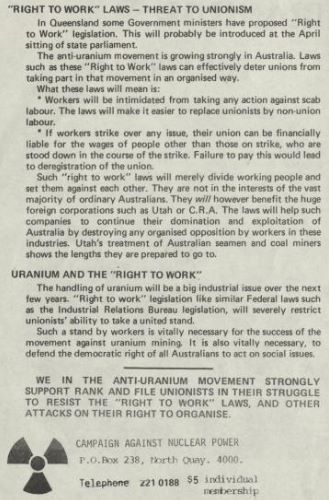
Combining multiple agendas, they used this argument as a call to arms to simultaneously stymie the nuclear industry and protect citizens’ rights (Figure 4).
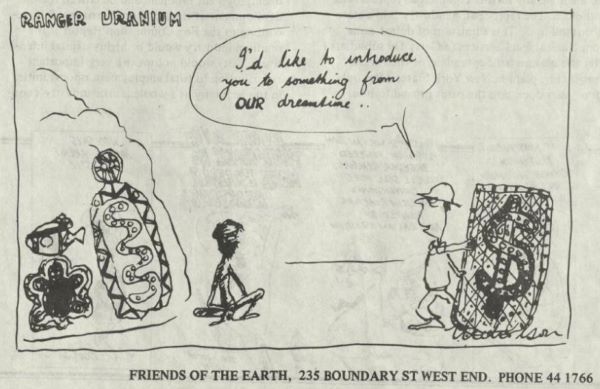
Campaign materials also consistently linked uranium mining to the erosion of First Nations culture and rights. Years of abuse had been swept under the carpet, with secret nuclear testing across Aboriginal lands of central and south Australia impacting Pitjantjatjara, Yankunytjatjara, Tjarutjam, Kokatha, Adnyamathanha, Dieri, and Kuyani people. By the 1970s, FoE was steadfastly calling out what they would later describe as “radioactive racism:” the trampling of First Nations culture, health, and rights by the uranium mining industry (Figure 5).
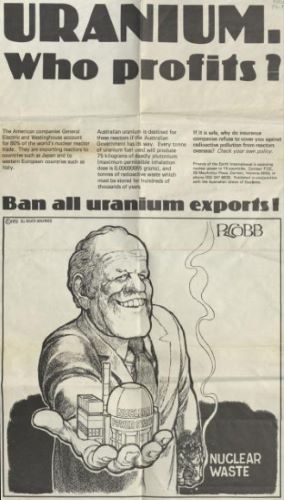
A second prevalent theme in movement material was distrust of perceived profiteering and power grabbing by the nuclear industry (Figure 6). Flyers highlighted the Harrisburg Three Mile Island partial meltdown disaster in Pennsylvania on 28 March 1979, arguing that plant management and “nuclear authorities” withheld information from residents and workers while lying to police and civil authorities. Other flyers provided extensive detail on the Browns Ferry (Alabama) near-meltdown incident of 22 March 1975, highlighting the multiple failures by plant managers.
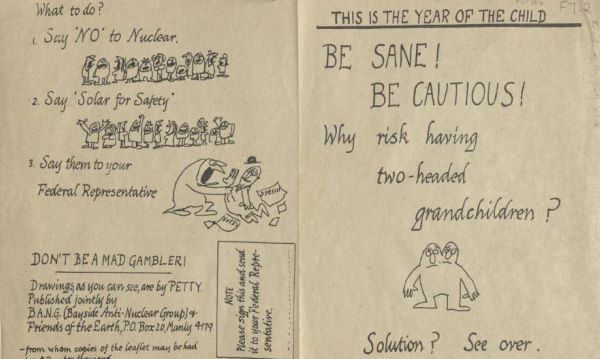
It is the less prevalent third theme where concern around impacts on nature surfaced, linked most frequently to human health. Whether from “dirty bomb” fallout caused by illicit groups accessing the plutonium black market, radioactive annihilation caused by state-sponsored global nuclear war, or downstream effects of uranium-mining waste products, images of radioactive burns and two-headed children appeared across a multiplicity of campaign materials (Figure 7).
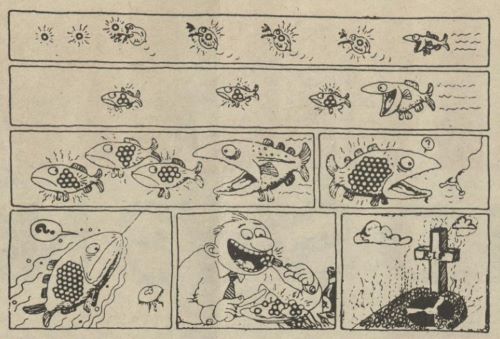
Signs that nature had an intrinsic value unconnected to human needs were conveyed primarily by FoE groups, who banded together under the umbrella of an “international environmental action network seeking to safeguard the Earth.” FoE’s A Slow Burn publication (issue 1, September 1974) argued that “the plutonium future must be rejected for what it is, an invitation to global ecological cataclysm.” The same year, an academic paper by John P. Holdren entitled “Radioactive Pollution of the Environment by the Nuclear Fuel Cycle” was reproduced, which linked uranium-mining waste at Jabiru to the death of aquatic plants and animals. Flyers noted how trace metals from uranium-mining waste products entered watercourses and polluted local water. Still, imagery and text most frequently linked these to risks to humans (Figures 7 and 8).
These materials suggest a degree of fear regarding nuclear technology’s impact on nature. However, by the 1970s, nature’s intrinsic value was yet to provide an independent rationale for challenging the nuclear industry. Perhaps the arguments against nuclear technology were so great, the salience of indiscriminate testing in neighboring Pacific islands so high, and the memories of nuclear terror in Hiroshima and Nagasaki in Japan so fresh, that arguments highlighting human risks were sufficient to underpin antinuclear agitation. Indeed, nuclear power stations were never built in Australia, Brisbane passed an antinuclear policy in 1983, and the siting of nuclear disposal repositories remains deeply contentious today. Thus, an enduring legacy of antinuclear activism may not only be the expression of defiance against the nuclear industry, but also the strengthening of a narrative connecting human survival to nature’s beneficence. In the nuclear age, we are no longer the true masters of our own fate. It is nature’s mercy on which we all depend.
Originally published by Arcadia: Explorations in Environmental History, 9 (Summer 2023), under a Creative Commons Attribution 4.0 International license.
